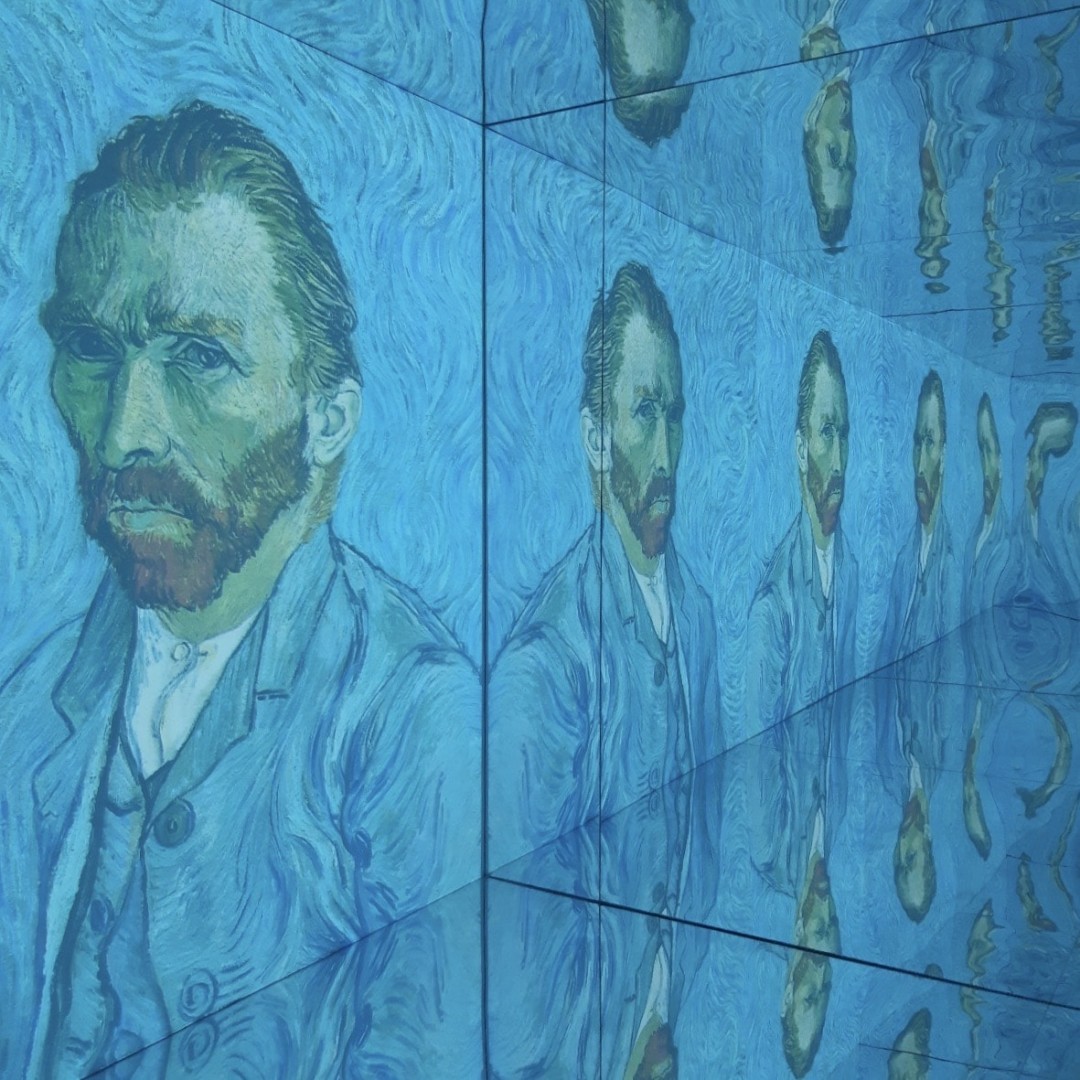Imagine Gustav Klimt’s tender motifs, with their gleaming, golden elements, projected onto huge concrete walls. This fascinating vision has become an immersive exhibition at the new ‘Les Bassin de Lumières,’ a digital art centre by CULTURESPACES, housed in a former submarine base in Bordeaux, France. Soon after its opening in June 2020, images of the digital show with video-projections of works by great artists, such as Gustav Klimt or Paul Klee, spread like wildfire around the world, prompting curiosity in contemporary methods of exhibiting classic artworks. Methods like those employed in Bordeaux go beyond traditional formats, such as salon-style displays, to absorb the viewer into the artwork through the use of technological tools. But what opportunities can be offered by immersive exhibitions like ‘Les Bassin de Lumières’?
In this article, we examine how the relation with the viewer has changed compared to the experience in a classical museum, then we investigate how the artwork fits into this new understanding. By looking at the relevance of immersive experiences, we underline its potential as a place of education, particularly for young people, for whom technology may play a key role in their ability to learn about and make sense of art. As we will show, the pedagogical value of immersive exhibitions is of great importance for museums using traditional methods to display visual arts or artefacts, even though there are practical challenges in bringing them to fruition.
Interactive exhibitions challenge the linear relation between spectator and art by engaging the viewer.
For several centuries, industry professionals and scholars have considered museums and art spaces as places of education and critical engagement. The typical exhibition, with static displays and often analysed as a discursive formation in theory, presents objects in a way that Bal describes as implying ‘Look! […] That’s how it is,’ exuding a sense of epistemic authority. Interactive exhibitions, on the other hand, challenge the linear relation between spectator and art by engaging the viewer, whereas recent immersive exhibitions even go one step further. Such tech-based exhibitions trigger a sensual experience of art, encouraging new ways of contemplating our perception of art – an active experience in and of itself – through their use of sound and movement. This concept not only calls the hierarchical structure of discursive exhibitions into question but also shows how important it is to think about the creation of meaning and learning through digital art.
Given that many people have learned to appreciate art through traditional exhibitions, one could ask ‘Why pay to see a digital copy of artwork X, Y, or Z when visitors know it is not the real thing?’ Or perhaps even more importantly, ‘Is it right to market an exhibition that displays a digital copy of artwork X, Y, or Z with the same significance as an exhibition of the real works themselves?’ Such questions are misguided, however. A digital copy of an artwork will never be the artwork itself, and the curators of immersive exhibitions know as much. Comparing the two is a fruitless endeavour because the video projections are not intended to be stand-ins for the originals. Simone Mazzarelli, CEO of the Italian marketing agency Ninetynine, expressed this difference in his talk at the 2017 conference ‘Museum Digital Transformation,’ saying, “You’re not [visiting] to look at Klimt’s paintings. It is new content […] you are surrounded by the world of Klimt, by his content, by the power of this atmosphere […] you are only inside an atmosphere that’s based on the artist” (Mazzarelli 2017).
The main value … is ‘its ability to provide a better explanation of the value and significance of art and to explain ways in which people actually think and talk about it.’
Mazarrelli’s comments strike at the heart of what visitors to immersive exhibitions are looking for. Black examined the needs of the future’s largest demographic, today’s under-35s, noting that they ‘appear to be more demanding, seek more active experiences, have higher expectations from what is on offer and are less willing to accept poor quality […] Research suggests many do not like traditional museums. They do not want to ‘”learn” through traditional static displays but rather respond increasingly to a more sensual/emotional experience’. This echoes what Graham described as ‘aesthetic cognitivism,’ the main value of which, he maintains, is ‘its ability to provide a better explanation of the value and significance of art and to explain ways in which people actually think and talk about it.’ (Graham, 1995) In this regard, digital exhibitions fit the bill to a tee, with atmospheres that have the potential to mentally engage visitors in their experiences and perception of the meaning of art. This is done by way of matching visitors’ capacity of attention with their spectacular moving images, immersive installations, and sounds. We call this the spectacle, which Apor considers to be of use of in exhibitions as a bid to “maintain interest and attract the young”.
This explains why people are triggered to share content of immersive exhibitions on their social media channels: it is a concrete form of producing narration and a form of memory work.
This interest is increased by the shareability of immersive exhibitions, like the one at Les Bassin de Lumières, which has its own social media accounts and encourages visitors to share their pictures of the virtual artworks. Indeed, much of the immersive exhibition experience is as much about taking pictures for social media as they are about enjoying the artworks, ultimately increasing the total engagement with exhibited content. This focus on getting the perfect picture to share, however, does not necessarily detract from the visitor’s ability to engage with or learn from the exhibition. Indeed, Sitzia explains this trend by referring to our thinking ‘through narratives’ and the natural process to ‘remember in narratives’. It is through this, she contends, that the viewer seeks to create meaning in the museum.
This explains why people are triggered to share content of immersive exhibitions on their social media channels: it is a concrete form of producing narration and a form of memory work. Young people, in particular, are ‘more comfortable with new media than with traditional communication means,’ according to Carrozzino and Bergamasco, and some of the leading producers of immersive exhibitions have been careful to recognize this.

The Florence-based production company Crossmedia has demonstrated mastery of the need to make immersive exhibitions shareable, implementing opportunities for sharing into their exhibition designs. Tommaso Mattei, director of communication and marketing, described the inclusion of the Mirror Room in Crossmedia’s exhibitions – or rather, experiences, as they like the call them – in a bid to get visitors to take out their smartphones: ‘We introduced the famous Mirror Room for the beauty of its content, but also with an eye towards social media […] A room made entirely of mirrors where images of the artworks are projected onto the walls, floor, ceiling and your body. You go in there and you’re going to take a selfie’. Such a design choice can ultimately increase the overall engagement with these contemporary visual representations of classical works and artefacts, inviting visitors to create meanings as they ‘think through narratives,’ as Sitzia says.
Not all museum staff are as open to the idea of immersive exhibitions as Crossmedia and Les Bassin de Lumières, however, not least because of the high costs associated with them. As they grapple with the need to bring in more money due to decreases in funding, professionals also need to evaluate if costly technology, which might need rigorous maintenance and trained staff, will offer enough benefits in terms of higher visitor numbers – and by extension, greater revenue – and more positive visitor experiences.
By looking at the digital copy of an artwork, the viewer can reject ‘naive realism’ of art…
Such positive experiences have historically been measured in terms of learning, and proponents of immersive exhibitions see art spaces as ‘informal places of education’ which can map out the opportunities that advanced technological tools provide while creating a satisfactory, entertaining experience for the recipient. As we have moved into the era of new museology, many scholars have come to view immersive exhibitions as places of intuitive learning, while conventional or discursively-designed exhibitions are for reflective learning, which, according to Sitzia, allows a ‘[…] generalization of the experience, leading to the abstract conceptualization phase’. Considering that immersive exhibitions are in and of themselves a technical abstraction of the world, is it not possible that recipients can engage with digital art on a meta-level level as well? Antonetti and Cantoia suggest that by looking at the digital copy of an artwork, the viewer can reject ‘naive realism’ of art since virtual reality can stimulate abstraction and imagination (ibid.: 222). The implication, as Antonetti and Cantoia emphasize, thus becomes that ‘we give a sense to our experience by referring to what we know and to what we can interact with’ in a sensorial way, as it is the case with digital displays of classical art. This level of free-choice and multi-form learning, key features of immersive exhibitions, are important aspects in museology.
The popularity of immersive exhibitions might have traditionalists wondering if this is really what we have come to, seeking satisfaction by sharing a picture in the hopes that it will rack up likes. This thinking might be justified in some measure, but recent research has shown the potential of digital art forms. Far from being gimmicky, immersive exhibitions can actually be educational and allow for critical engagement. These kinds of shows can also introduce the arts to entire segments of visitors who would otherwise show little interest in the museum. Moreover, for the demanding audience that Black identified, exhibitions that are immersive in part or in their entirety can be the very thing that appeals to visitors looking for sensual or emotional experiences. For this reason alone, skeptical museum professionals may very well find themselves making space for immersive elements in their displays in near future.
References:
Antonietti, A. and M. Cantoia (2000). “To see a painting versus to walk in a painting: an experiment on sense-making through virtual reality.” Computers & Education 34: 213-223.
Bailey-Ross, C. and e. al. (2017). “Engaging the museum space: Mobilizing visitor engagement with digital content creation.” Digital Scholarship in the Humanities 32(4): 689-708.
Bal, M. (1996). Double exposures : the subject of cultural analysis. New York, Routledge.
Carrozzino, M. and M. Bergamasco (2010). “Beyond virtual museums: Experiencing immersive virtual reality in real museums.” Journal of Cultural Heritage 11: 452-458.
Gaitatzes, A., D. Christopoulos and M. Roussou (2002). Reviving the past: Cultural Heritage meets Virtual Reality. VAST01: Virtual Reality, Archaeology and Cultural Heritage, Glyfada, Greece, Association for Computing Machinery.
Graham, G. (1995). ‘Learning from Art,’ The British Journal of Aesthetics, 35(1), pp. 26-37.
Hooper-Greenhill, E. (2007). Learning in the post-museum: issues and challenges. Museums and Education: Purpose, Pedagogy, Performance. E. Hooper-Greenhill. Oxon, Routledge: 189-202.
Hood, M. (1993) ‘After 70 Years of Audience Research, What Have We Learned? Who Comes to Museums, Who Does Not, and Why?’ Visitor Studies, 5(1): pp. 16–27.
Lang, C. (2016) ‘The Public Access Debate’, in Lang, C. and Reeve, J. (eds) The Responsive Museum: Working with Audiences in the Twenty-First Century. London: Routledge, pp. 29-38.
Mattei, T (2018) Interviewed by Author, December 2018.
Mazzarelli, S. (2017) ‘The evolution of the relationship between technology, entertainment and art and how the art can be considered like a consumer product thanks to dedicated marketing strategies’, Museum Digital Transformation. Centro Arte e Cultura, 24-25 March. Florence: Opera di Santa Maria del Fiore.
Roussou, M. (2001). Immersive Interactive Virtual Reality in the Museum. TiLE – Trends in Leisure Entertainment London, Aldrich, Proceedings of TiLE.
Sitzia, E. (2016). “Narrative Theories and Learning in Contemporary Art Museums: A Theoretical Exploration.” Stedelijk Studies 4.
Smith, L. (2015) ‘Theorizing Museum and Heritage Visiting’, in Witcomb, A. and Message, K. (eds) The International Handbooks of Museum Studies: Museum Theory. Chichester: Wiley Blackwell, pp. 459-484.






